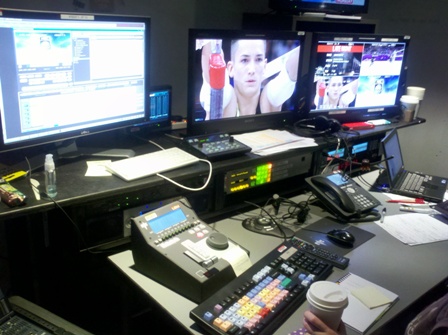Servers at NBC: Tapping the Technology
LONDON—NBC has played its part in the story of servers at big event broadcasting, using some of the very first Tektronix Profiles in its 1996 Atlanta effort for all the benefits that would become expected in a record device----nonlinear access, time-shifting programming, playing back while simultaneously recording and more

.
Fast-forward ten years, and EVS servers dominated the playback wall at NBC’s Torino facility. In London EVS continued to play its part. Its blue boxes again played a major role, this time as part of NBC’s integrated network of EVS, Avid, Sony and Harmonic record and storage equipment.
“EVS is all the fast-turnaround, slo-mo, ingest-for-air, and playout-for-air,” said David Mazza, senior vice president of engineering, NBC Olympics. “If it’s three shots together with a dissolve, it’s coming off an EVS.”
But the NBC server story goes beyond the core, rock-solid recording of its ingest wall. In London the network arrived at a point they had been seeking for a decade: NBC finally achieved an Enterprise Asset Management workflow that was location independent—it no longer matters where a user is retrieving clips from, or where they are being sent. It’s a tale of integration between best-of-breed servers and storage.
Each vendor contributed its part. EVS servers and a wall of Sony XDS XDCAM recorders were the tip of the spear for broadcast ingest workflows. The EVS servers also managed a lot of playback. Harmonic was central to storage and cross-Atlantic file transfers.
Avid played its obvious role on the craft side, but the vendor’s Interplay MAM software/hardware was central to NBC’s London workflow.
The Interplay MAM is a desktop interface that allows users to have a single ingest point serving multiple outputs. It provides overarching media management and stores all related metadata. A full year of development of the Interplay MAM by NBC staff and Avid developers was key to ironing out the integrati

on, said Mazza.
Other softwares were also ubiquitous at the London IBC. About 20 EVS IPDirector stations were used in NBC’s IBC, and many more at venues. These performed a variety of tasks—from managing ingest on the EVS servers to managing the nearline storage off of the Harmonic MediaGrid.
Any content that gets ingested and backed up for several days is managed through IPDirector. Media managers and ADs, producers and others can quickly do a search for something like “Phelps Gold” and they’ll see every instance of “Phelps Gold” based on user-defined metadata, names of clips, time code, creation dates, camera angle, etc., even of content that had been transferred to the nearline storage.
London-based writers also made use of a remote IPDirector to access material on New York XTs that was just on the edge of playout. “They can see the material after it’s been through the whole process in New York, and write the script copy for the on-air people to read,” said Darryl Jefferson, project manager for the Highlights Factory and director of post production operations for NBC Olympics.
Another software that saw a lot of use was EVS IPBrowse. The “Fetcher room” was a big example. Here, staffers were “fetching” all kinds of content for users in New York and London.
These fetchers could access content from other systems, NBC’s assets and even the OBS IPBrowse server. One benefit of this software was its simple operation—fetchers only needed a 30-minute training session as preparation. Fetchers also had access to Media Composer and other softwares/VTRs to find and access whatever they needed.
ENHANCED METADATA
Tracking and searching for content in a high-volume operation is critical. In London, NBC took a host broadcaster service called the Broadcast Data Feed, directly into files in its MAM. This feed had within it all the logs from the massive OBS pool of EVS servers and more, and this became a searchable metadata strata in the MAM. It supplemented NBC’s own logging and a real-time stats feed.
“This increased visibility clip-by-clip and added value to all host assets,” said Jefferson. “The BDF adds value to all host assets, making them easier to find and providing more information.”
Jefferson said the BDF also provides clip duration and captures key frames. If a log event lasts for 48 frames, when a user looks in the MAM there’s a key frame for every frame. This is something that NBC’s system could not do without the integration of the BDF into the MAM.
The professional video industry's #1 source for news, trends and product and tech information. Sign up below.

